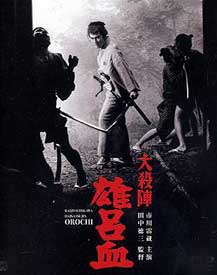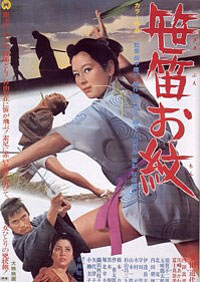 Tokuzo Tanaka was a veteran chambara director whose works ranged from the sublime to the ridiculous. Tokuzo Tanaka was a veteran chambara director whose works ranged from the sublime to the ridiculous.
In the latter category of the ridiculous is Sasabue Omon or The Girl With the Bamboo Leaves (Daiei, 1969), from a recycled Zatoichi script which replaces the blind swordsman with a young woman (Michiyo Yasuda) who fights with bamboo leaves. Supporting cast included Takeshi Date as Chokichi, Manami Fuji as Oen, & Rytaro Gomi as Jirokichi.
Championing the weak, "Bamboo Omon" uses bamboo leaves like shurikens, & bamboo branches with leaves intact like a sword. Bad guys with real swords are helpless against her swishing branches.
When she throws her deadly leaves, really bad animated leaves are drawn into the fight scenes, zipping around & cutting people. As if that ain't dumb enough, her costume is rather too close to a miniskirt or a Robin Hood or forest pixie outfit.
When the script was first filmed with Shintaro Katsu as Masseur Ichi, it wasn't too bad a story, but on this re-do, both the costuming for the heroine, & her alleged "weapon," never rise above the absurd.
While I might agree the kind of papercuts you can get from bamboo leaves are annoying, nothing in the image of a slip of a girl hopping about & swiping her leaves at bad guys who have actual swords looks like a fight.
It's truly a damnable low effort even for B-grade chambara, such as tended on average to be fairly good films in the 60s, but not this time.
It's especially surprising how bad the film is, since Tanaka directed fair to good films most of the time, including early Zatoichi episodes which helped set the tone of the long-running series, & the Hoodlum Soldier series which likewise starred Katsu.
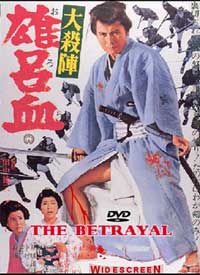 Tanaka started out under the wing of the great Kenji Mizoguchi, & was first assistant director on Mizoguchi's masterpiece Ugetsu monogatari (1953).
Tanaka started out under the wing of the great Kenji Mizoguchi, & was first assistant director on Mizoguchi's masterpiece Ugetsu monogatari (1953).
And Tanaka on his own had at least one truly brilliant film, Daisatsujin orochi (The Betrayal, 1966) starring Raizo Ichikawa, whom Tanaka also directed in one of the Full Moon Swordsman/Sleepy Eyes of Death films.
The Betrayal aka Great Slaughter & the Serpent co-starred Raizo's favorite leading lady Shiho Fujimura as the girl who trusted, helped, & was not rewarded for her goodness. There are supporting roles from Kaoru Yachigusa & Ichiro Nakaya, & a superb script by Seiji Hoshikawa.
Cinematographer Chishi Makiura was responsible for the look of many well-known films about Zatoichi, Lone Wolf with Child, the Full Moon Swordsman, as well as some moody period kaidan or ghost films.
I first saw Daisatsujin orochi on an enormous screen in scope at the now long lamented Kokusai Theater in Seattle.
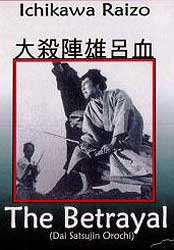 When I staggered out of the theater, much as Raizo staggering over the field of the dead, I was weak-kneed, dry-mouthed, & overawed. It was one of a handful of times I felt that a virtually unknown film should be regarded as a classic. When I staggered out of the theater, much as Raizo staggering over the field of the dead, I was weak-kneed, dry-mouthed, & overawed. It was one of a handful of times I felt that a virtually unknown film should be regarded as a classic.
Thirty years later it is finally available as a subtitled DVD, but still hard for just anyone to see it, as it's not the sort of film to show up in most rental stocks.
The black & white cinematography has a classic, gloomy gorgeousness. As the story unfolds, a naively honorable samurai (played by Raizo) comes to the bitter realization that his devotion to moral samurai principles makes him an oddity among his peers, & a very vulnerable oddity in consequence.
He takes the blame for the misdeeds of others, with the understanding that he will be exiled for one year & restored to the clan's good graces after the political situation dies down. But as betrayal begins to heap upon betrayal, he realizes he'll have to live out his life as a masterless ronin, if not hunted down & killed.
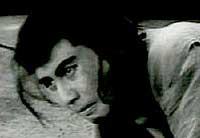 This film can stand alongside Harakiri (1964) starring Tatsuya Nakadai & Bushido Samurai Saga (1963) starring Kinnosuke Nakamura as a great "anti-samurai" or "cruel jidai-geki" film with brutal realism & its attendant emotional distress. This film can stand alongside Harakiri (1964) starring Tatsuya Nakadai & Bushido Samurai Saga (1963) starring Kinnosuke Nakamura as a great "anti-samurai" or "cruel jidai-geki" film with brutal realism & its attendant emotional distress.
The extended one-against-all swordfight that concludes the tale is shot with a horrific degree of reality. Our hero becomes grotesquely weary, his hand clutched so tight to his sword's hilt that when it breaks off, he has trouble letting loose of it in order to take up another sword.
He becomes so dehydrated from exertion that he begins staggering weakly & has to try to get water from a well as multiples of foe wait for the moment when he is least on guard. At the similarly protracted conclusion of Sword of Doom (1966) to which The Betrayal has been compared, Tatsuya Nakadai with his evil but undefeatable sword style is like an elemental being from hell. But Raizo in a similar one-against-all whirlwind is like an innocent figure trapped in hell, battling against his will & as much in terror of his own actions as he is of what would happen to him if he stopped.
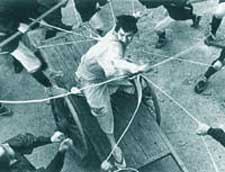 Ten minutes of non-stop carnage begins with his one-against-all-yakuza, then one against his entire clan, & just when it seems impossible to go on, one against all the rival clan, even though by then they are willing to admit it no longer seems believable that a swordsman of his ability was guilty of the rear-attack murder that started this fiasco. Ten minutes of non-stop carnage begins with his one-against-all-yakuza, then one against his entire clan, & just when it seems impossible to go on, one against all the rival clan, even though by then they are willing to admit it no longer seems believable that a swordsman of his ability was guilty of the rear-attack murder that started this fiasco.
Even acknowledged as innocent, samurai pride will not permit the carnage to stop. Whether or not he can survive, with our hero's hard breathing, staggering weariness, at times barely able to stand, it is tortuous & agonizing to watch him.
The final images of Raizo's worn-down figure still standing, if only barely, above the carnage, with his girlfriend (Kaoru Yachigusa) knelt before him, has less a sense of victory about it than a sense of appalling disgust with a warrior culture that could lead to such a monstrous moment.
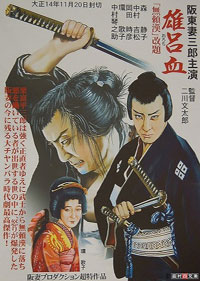 This great film is a revised remake of Buntaro Futagawa's The Serpent (Orochi, Bantsuma Productions, 1925), which happily survives though so few films from this era do. This great film is a revised remake of Buntaro Futagawa's The Serpent (Orochi, Bantsuma Productions, 1925), which happily survives though so few films from this era do.
It stars Bando Tsumasaburo, the Toshiro Mifune of his day, broad-shouldered & menacing in his fighting posture even before he makes a move.
His own production company made this the company's second feature, providing him the opportunity to achieve his desire to play characters with greater psychological realism than generally seen in the silent era, something more appealing to the educated.
So too Bantsuma longed to escape from under the thumbs of the benshi narrators who were big stars in their own right, & who continuously held films back from advanced storytelling in favor of illustrations for their own pre-existent repertoir.
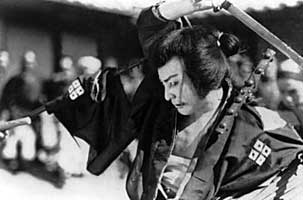 Bando's portrayal of Heizaburo has him at first an idealistic or naive vassal, penultimately a bitter & nihilistic ronin uncertain that the difference between right & wrong even matters. Bando's portrayal of Heizaburo has him at first an idealistic or naive vassal, penultimately a bitter & nihilistic ronin uncertain that the difference between right & wrong even matters.
In the finale he is willing to take a stand against injustice no matter what it costs him. His leading lady is Takako Irie, later famous for playing "ghost-cat" roles.
He's a victimized figure even if not quite as innocent as in the remake with Raizo at center stage. It is relentlessly gloomy with a huge amount of swordplay action that was revolutionary at the time for its gruesome conviction.
Some of the action sequences were imitated very closely in the remake, & Raizo imitated Bando's body language, which could not be improved.
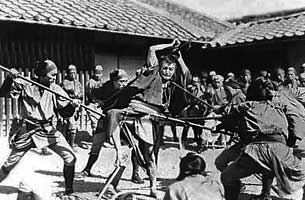 Full of dark shadows & gloom, one half expects a horror film, & by the time we reach the catostrophic conclusion, all-out violent horror is what it becomes. Full of dark shadows & gloom, one half expects a horror film, & by the time we reach the catostrophic conclusion, all-out violent horror is what it becomes.
As real as Bantsuma wanted to make the emotional content of a film, he was even more devoted to the action, & staged a one-against-all battle that at the time overawed audiences who'd never seen the likes before.
Even now the amazing action has authority, with great emotional content to every movement of Bantsuma's body.
Some of Bantsuma's choreography frankly had the greater emotional content, being not improved upon in the remake.
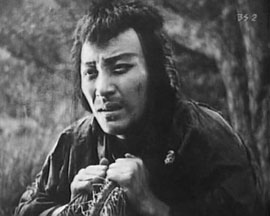 For example, in one one important scene for Raizo's action, he breaks his sword but his grip is frozen to the hilt, & he cannot immediately get the sword loose in order to take up another weapon. But Bantsuma discovers his hand frozen to the hilt under different circumstances entirely. For example, in one one important scene for Raizo's action, he breaks his sword but his grip is frozen to the hilt, & he cannot immediately get the sword loose in order to take up another weapon. But Bantsuma discovers his hand frozen to the hilt under different circumstances entirely.
By Bantsuma's amazing capacity for silent film emotion, we can see in Heizaburo's face that he has become horrified by his own vicious slaying. Even if they kill him, he intends to throw down his sword! Only, he can't do so. His agonized fingers are frozen in their grip.
He is in the end overcome, bound & defeated with a look of profound sadness, quite a different outcome than in the remake that has Raizo the last man standing, still in the thrall of his sense of horror.
Orochi reveals that director Futagawa deserves to share the spotlight with Masahiro Makino & Daisuke Ito for investing samurai fiction with adult story values including social awareness & a degree of realism.
copyright © by Paghat the Ratgirl
|

